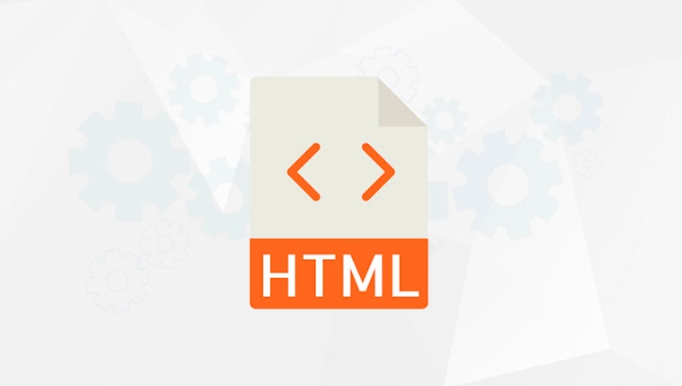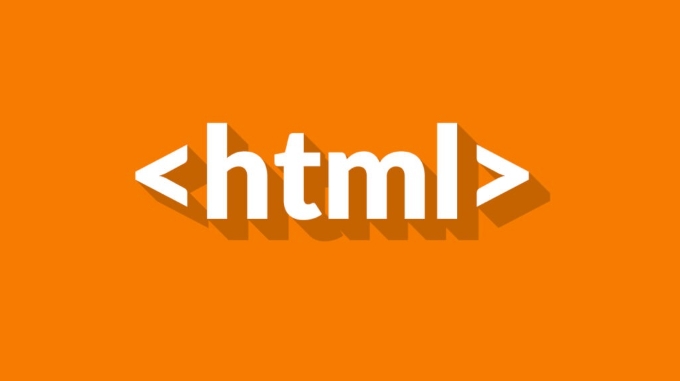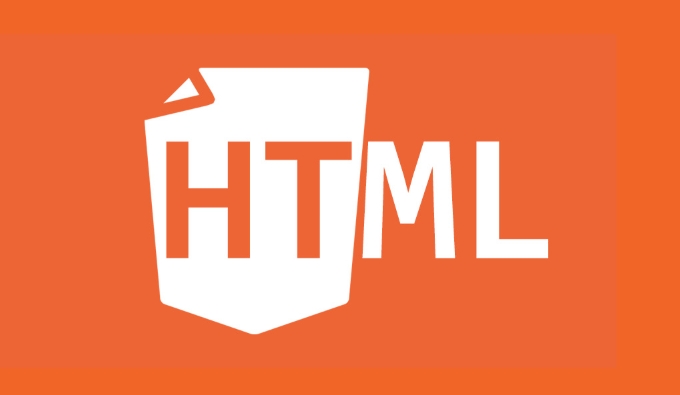The crossorigin attribute is used to control the CORS behavior when HTML resource cross-domain requests. Common values are anonymous and use-credentials. 1. It is mainly used in image, script, style sheet and other resource tags such as <img src="/static/imghw/default1.png" data-src="https://img.php.cn/upload/article/000/000/000/175346120315892.jpeg" class="lazy" alt="HTML `crossorigin` Attribute for CORS" >, <script>, <link>, to determine whether the browser enables the CORS mechanism; 2. The value anonymous means sending CORS requests without credentials, and the server requires credentials to be allowed by use-credentials; 3. Common scenarios include: Canvas drawing requires crossorigin to prevent pollution, CDN loads resources with the server CORS configuration, use use-credentials when authenticated access is required, and ensures that the server response header is correct. Incorrect settings may cause resource loading failures or security policy issues. </script>

In HTML, the crossorigin attribute is mainly used to control the behavior of certain resources (such as images, scripts, style sheets, etc.) when requesting across domains, especially related to the CORS (cross-domain resource sharing) mechanism. Although it looks simple, it may cause resource loading to fail or security policies to be bypassed.

If you encounter an error like "Blocked by CORS policy" when loading external resources, it is likely that crossorigin property is not set correctly.
What is crossorigin attribute?
crossorigin is an attribute in HTML tags, commonly found in <img src="/static/imghw/default1.png" data-src="https://img.php.cn/upload/article/000/000/000/175346120315892.jpeg" class="lazy" alt="HTML `crossorigin` Attribute for CORS" > , <script></script> , <link> and other tags. Its purpose is to tell the browser whether to enable CORS when requesting the resource.

for example:
<img src="/static/imghw/default1.png" data-src="https://example.com/image.jpg" class="lazy" crossorigin="anonymous" alt="HTML `crossorigin` Attribute for CORS" >
This property itself does not automatically resolve cross-domain issues, but it affects how the browser handles requests and responses. Without this attribute, some resources cannot be used for certain scenarios that require a safe context, such as drawing on Canvas, even if they can be displayed normally.

What are the commonly used values of crossorigin ?
This property supports two commonly used values, and there are some special usages that need to be paid attention to:
- anonymous : This is the most commonly used value. Indicates that a CORS request is sent without credentials (such as cookies, HTTP authentication) when requesting a resource.
- use-credentials : brings credentials when requesting, but the server must allow credentials in the response header (
Access-Control-Allow-Credentials: true) otherwise it will be rejected. - Null value or not written : equivalent to
anonymous, but omission is not recommended because the semantics are not clear enough.
for example:
<script src="https://cdn.example.com/script.js" crossorigin="anonymous"></script>
Common usage scenarios and precautions
1. crossorigin must be set when using Canvas
If you load an image from another domain name and plan to operate it with <canvas> (such as screenshots, filters, etc.), you must set the crossorigin attribute, otherwise the browser will think that the image is "polluted" and cannot perform subsequent operations.
Error example:
<img src="/static/imghw/default1.png" data-src="https://other.com/image.png" class="lazy" id="img" alt="HTML `crossorigin` Attribute for CORS" > <canvas id="canvas"></canvas> // Draw pictures in JS to canvas const ctx = canvas.getContext('2d'); ctx.drawImage(img, 0, 0); // Error: Canvas is tainted
Correct way to do it:
<img src="/static/imghw/default1.png" data-src="https://other.com/image.png" class="lazy" crossorigin="anonymous" id="img" alt="HTML `crossorigin` Attribute for CORS" >
2. Pay attention to the CDN resource loading scripts or fonts.
If you load JS or font resources from CDN and the CDN has CORS policy configured, then adding crossorigin can ensure that the loading process is more controllable. for example:
<script src="https://cdn.example.com/your-script.js" crossorigin="anonymous"></script>
If the server does not set Access-Control-Allow-Origin correctly, it may be intercepted by the browser even if the resource can be loaded.
3. When using use-credentials the server must cooperate
If you need to bring cookies or authentication information, such as accessing a resource under permission, you must set it:
<img src="/static/imghw/default1.png" data-src="https://api.example.com/secure-image.png" class="lazy" crossorigin="use-credentials" alt="HTML `crossorigin` Attribute for CORS" >
At the same time, the server response header must include:
Access-Control-Allow-Origin: https://your-site.com Access-Control-Allow-Credentials: true
Otherwise, the browser will still intercept the request.
Let's summarize
- The
crossoriginproperty is not omnipotent, but it is the first step to enable CORS. - Pay attention to server configuration when using different resource types (pictures, scripts, fonts).
- Setting
anonymousis the right choice for most cases. - If you use Canvas or need authentication access, select
use-credentialsaccording to the situation.
Basically that's it. Pay more attention to the resource source and server response header when using it, so that many "cross-domain failure" problems can be avoided.
The above is the detailed content of HTML `crossorigin` Attribute for CORS. For more information, please follow other related articles on the PHP Chinese website!

Hot AI Tools

Undress AI Tool
Undress images for free

Undresser.AI Undress
AI-powered app for creating realistic nude photos

AI Clothes Remover
Online AI tool for removing clothes from photos.

Clothoff.io
AI clothes remover

Video Face Swap
Swap faces in any video effortlessly with our completely free AI face swap tool!

Hot Article

Hot Tools

Notepad++7.3.1
Easy-to-use and free code editor

SublimeText3 Chinese version
Chinese version, very easy to use

Zend Studio 13.0.1
Powerful PHP integrated development environment

Dreamweaver CS6
Visual web development tools

SublimeText3 Mac version
God-level code editing software (SublimeText3)
 The `` vs. `` in HTML
Jul 19, 2025 am 12:41 AM
The `` vs. `` in HTML
Jul 19, 2025 am 12:41 AM
It is a block-level element, used to divide large block content areas; it is an inline element, suitable for wrapping small segments of text or content fragments. The specific differences are as follows: 1. Exclusively occupy a row, width and height, inner and outer margins can be set, which are often used in layout structures such as headers, sidebars, etc.; 2. Do not wrap lines, only occupy the content width, and are used for local style control such as discoloration, bolding, etc.; 3. In terms of usage scenarios, it is suitable for the layout and structure organization of the overall area, and is used for small-scale style adjustments that do not affect the overall layout; 4. When nesting, it can contain any elements, and block-level elements should not be nested inside.
 Essential HTML Tags for Beginners
Jul 27, 2025 am 03:45 AM
Essential HTML Tags for Beginners
Jul 27, 2025 am 03:45 AM
To get started with HTML quickly, you only need to master a few basic tags to build a web skeleton. 1. The page structure is essential, and, which is the root element, contains meta information, and is the content display area. 2. Use the title. The higher the level, the smaller the number. Use tags to segment the text to avoid skipping the level. 3. The link uses tags and matches the href attributes, and the image uses tags and contains src and alt attributes. 4. The list is divided into unordered lists and ordered lists. Each entry is represented and must be nested in the list. 5. Beginners don’t have to force memorize all tags. It is more efficient to write and check them while you are writing. Master the structure, text, links, pictures and lists to create basic web pages.
 Shadow DOM Concepts and HTML Integration
Jul 24, 2025 am 01:39 AM
Shadow DOM Concepts and HTML Integration
Jul 24, 2025 am 01:39 AM
ShadowDOM is a technology used in web component technology to create isolated DOM subtrees. 1. It allows the mount of an independent DOM structure on ordinary HTML elements, with its own styles and behaviors, and does not affect the main document; 2. Created through JavaScript, such as using the attachShadow method and setting the mode to open; 3. When used in combination with HTML, it has three major features: clear structure, style isolation and content projection (slot); 4. Notes include complex debugging, style scope control, performance overhead and framework compatibility issues. In short, ShadowDOM provides native encapsulation capabilities for building reusable and non-polluting UI components.
 HTML `style` Tag: Inline vs. Internal CSS
Jul 26, 2025 am 07:23 AM
HTML `style` Tag: Inline vs. Internal CSS
Jul 26, 2025 am 07:23 AM
The style placement method needs to be selected according to the scene. 1. Inline is suitable for temporary modification of single elements or dynamic JS control, such as the button color changes with operation; 2. Internal CSS is suitable for projects with few pages and simple structure, which is convenient for centralized management of styles, such as basic style settings of login pages; 3. Priority is given to reuse, maintenance and performance, and it is better to split external link CSS files for large projects.
 Why is my image not showing up in HTML?
Jul 28, 2025 am 02:08 AM
Why is my image not showing up in HTML?
Jul 28, 2025 am 02:08 AM
Image not displayed is usually caused by a wrong file path, incorrect file name or extension, HTML syntax issues, or browser cache. 1. Make sure that the src path is consistent with the actual location of the file and use the correct relative path; 2. Check whether the file name case and extension match exactly, and verify whether the image can be loaded by directly entering the URL; 3. Check whether the img tag syntax is correct, ensure that there are no redundant characters and the alt attribute value is appropriate; 4. Try to force refresh the page, clear the cache, or use incognito mode to eliminate cache interference. Troubleshooting in this order can solve most HTML image display problems.
 Can you put a tag inside another tag?
Jul 27, 2025 am 04:15 AM
Can you put a tag inside another tag?
Jul 27, 2025 am 04:15 AM
?Youcannotnesttagsinsideanothertagbecauseit’sinvalidHTML;browsersautomaticallyclosethefirstbeforeopeningthenext,resultinginseparateparagraphs.?Instead,useinlineelementslike,,orforstylingwithinaparagraph,orblockcontainerslikeortogroupmultipleparagraph
 HTML `link` for Prefetching DNS
Jul 23, 2025 am 02:19 AM
HTML `link` for Prefetching DNS
Jul 23, 2025 am 02:19 AM
Pre-resolving DNS can speed up page loading speed, and using HTML link tags for DNS pre-resolving is an effective method; DNSPrefetching saves subsequent request time by resolving domain names in advance; applicable scenarios include third-party fonts, advertising statistics scripts, resource hosting and CDN domain names; it is recommended to prioritize the main page dependency resources, reasonably control the number between 3 and 5, and use it with preconnect to better effect.
 The `optgroup` Tag in HTML `select`
Jul 19, 2025 am 02:01 AM
The `optgroup` Tag in HTML `select`
Jul 19, 2025 am 02:01 AM
In HTML forms, use tags to group options from the drop-down menu to improve readability and user experience. 1. It is a label under the element, used to group multiple groups and define group names through label attributes; 2. When using it, it needs to be placed inside and nested, and each must have a label attribute; 3. Notes include not being nested, the entire group options can be disabled through the disabled attribute, the CSS custom style can be used, and the need to consider accessibility support; 4. Applicable scenarios include multi-classified data selection, and the need to have visual hierarchy or logical hierarchy relationships. Rational use can effectively improve the interactive experience of the form.






